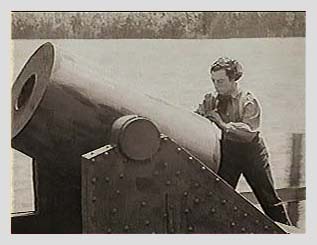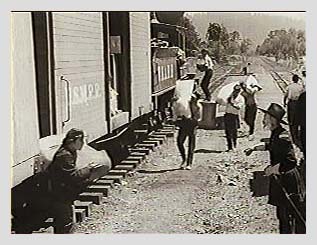

Where do you start in commenting on such a film as this? There isn't a better constructed comedy from the silent era in which all the elements work so well together for the ultimate artistry of the film.
First of all, the single biggest factor that makes this a great film (outside of Buster Keaton himself) is the storyline. No, it's not a "blow your mind" kind of story. It's a very basic and rather simple story, but therein lies its appeal. The comedy is given a chance to do its stuff because we are not bogged down in some complicated story littered with subplots, plot twists or whatever. The characters are not buried under the story line thereby subordinating them to the story. Credit must be given to Keaton and Clyde Bruckman for their adroit handling of this simple story with something so large as the Civil War going on all around it and yet still keeping it human and not overwhelming us with the spectacle. (Chaplin did this with "The Gold Rush" and Griffith did it with both "The Birth of a Nation" and "Hearts of the World").
Before giving too much credit to Keaton and Bruckman for the story, though, it must be noted that this is based on an actual event in which te real Capt. James J. Anderson, along with a handful of men, did steal a locomotive outside Atlanta, Ga., and attempted to head toward Chattanooga, Tenn., disrupting the Confederate's communications and railway system along the way. This is all recounted in an 1863 narrative entitled "Daring and Suffering: A History of the Great Railway Adventure" on which Keaton based "The General."
Keaton was also a stickler for detail and authenticity, and thanks to him, the film consistently gets high praise for its visual beauty, quite often described as having the look of a "Mathew Brady photograph," and indeed it does. Keaton had wanted to film it in its original location, but the Georgia countryside and rail system were unsuitable. He found just what he wanted in Oregon with plenty of pines, hillsides in the distance, and narrow-gauge rails just as they had during the Civil War. The result is a visually stunning film that makes good use of the charming Oregon countryside. The only small complaint would be the interiors at the beginning of the film which look cheap and reminiscent of some of his earlier two-reel comedies.
 Since this IS a comedy, let's not
forget the gags which are some of the best in all of Keatons'
work. Given the right props, any comedian worth his salt should
be able to come up with something funny, but, whether Keaton was
exceptionally inspired on this film or the props were just too
good not to have something hilarious result doesn't matter. What
does matter is that the gags are wonderful.
Since this IS a comedy, let's not
forget the gags which are some of the best in all of Keatons'
work. Given the right props, any comedian worth his salt should
be able to come up with something funny, but, whether Keaton was
exceptionally inspired on this film or the props were just too
good not to have something hilarious result doesn't matter. What
does matter is that the gags are wonderful.
In speaking of props, one of the most hilarious sequences in the film involves Buster's interaction with one of those stubby Southern mortar/cannons mounted on flat car. While traveling down the track, he tries to fire this at the train ahead which is full of Union soldiers. However, after loading and lighting the cannon, he heads back to his engine only to get his foot caught in the connector between the flatcar and his coal tender. Although he succeeds in getting his foot loose, the flat car has become disconnected. Because of the connector hitting the railroad ties, the cannon is jostled down from a 45 degree angle so that it is aiming straight for his engine. Buster climbs out onto the cow catcher at the front of the engine to get as far away from the blast as possible, but, just as the cannon fires, the train goes around a curve. Because of this, the cannon fires off to the side of Buster's engine and right at the Union train which is on a curve up ahead. The precision and timing with which this gag was executed are about as perfect as anyone could ask for. (Did you ever wonder how they find these locations that fit the gags so well?!!)
The film has plenty of these "large scale" gags (there are some great ones in the final battle scene most notably the train crashing through the burning bridge) throughout the film, but what makes it are the little ones. For example:
. . . Johnny is followed into Annebelle's house by two small boys who idolize the train engineer. Annoyed at their presence, Johnny gets up, puts his hat on, opens the door and lets the two boys go out ahead of him, then shuts the door behind them. He takes off his hat and resumes his tete-a-tete with Annabelle.
. . . After the Union soldiers fill their train with water, they rush off leaving the water gushing from the water tank. Johnny comes along and is drenched by the torrent. He steps out of the cab of the engine, looks up at the sky while holding his hand out as if checking for rain.
. . . Johnny steals a large sack which he plans to put Annabelle in so he can sneak her on the Union train. The sack is full of shoes, and Johnny pours them out on the ground. After getting Annabelle into the sack, one of his shoes comes off getting mixed up in the pile of shoes on the ground. He digs through the pile trying to figure out which one is his.
And there are dozens more, of course. However, some of the best gags in the film involved Annabelle, played by Marion Mack. In "The General" Keaton allowed his heroine to contribute more to the comedy than any of his heroines before. Much credit must be given to Mack, because she handled the responsibility well, and certainly this is one of the best casting jobs Keaton did for any of his films.
Although Mack's character does something "dumb"
on occasion, she is not presented as a "dumb" female.
Instead, she comes across as very feminine, a Southern lady who
is just unfamiliar with the circumstances into which Fate has
thrust her. For example:
. . . Carrying Annabelle over his shoulder in the sack to the Union train, Johnny backs up between boxcars while talking to a Union officer. We see Annabelle's hand slip out of the bag, remove the pin connecting the two boxcars and withdraw into the sack. Mission accomplished, and Johnny can move on. However, later, after Johnny has stolen the train, he goes into the boxcar to look for Annabelle. After getting her out of the sack, we see that Annabelle is still holding the pin in her hand and offers it to Johnny as if he has some use for it at this point!!
. . . As Annabelle and Johnny are trying to outrun the Union soldiers in their train, Johnny tells Annabelle to put more wood in the fire. She does so, but, when she runs across a piece of wood with a hole in it, she throws it off the train as if it is defective and can't be used!!
. . . During a stop in the chase to pick up wood, Annabelle takes a piece or rope and ties it between two small, spindly pine trees so that the rope stretches across the track. She feels this will detain the train. Johnny looks at it disgustedly as he pulls at the rope to show its flimsiness. Later, however, when the Union train runs into the rope, it snatches the trees up by their roots as expected, but, unexpectedly, the trees get caught up on the wheels of the engine causing them to stop and unloose the stoppages. Annabelle's plan worked after all!!
Finally, the battle scene at the end of the film is worthy of anything D.W. Griffith ever did. We see a battle on a grand scale over the river with hundreds of extras swarming about the river, smoke rising everywhere, explosions dotting the countryside, and an expert weaving of the narrative so we know what's going on in the battle and don't just see a lot of scurrying about without any purpose. One of the most beautiful shots in the film shows the silhouettes of soldiers advancing through the pines while shafts of sunlight pierce the woods. Smoke rises all around accentuating the sunlight and giving the soldiers a ghostly aura as they move toward the camera. Certainly, a scene such as this would have expected of Griffith or one of the German directors, not in a Keaton film!!
So much has been written about "The General" that there's little that can be added. It is, indeed, a great film and is regularly included in lists of the 50 or 100 best films of all-time. However, it took some time for this to come about. Audiences in 1927 didn't care for it, and the critics either dismissed it as unimpressive or blasted the film. It was considered a "financial disaster" for United Artists. Go figure. Keaton biographer Tom Dardis says the film was "just too good" for the audiences of the day. According to Dardis, it moved along at a crisp pace, and the unsophisticated audiences of the day simply couldn't follow it. Whatever the reason, the film has been given its rightful place in cinema history by film buffs today. As a matter of fact, this film is so good it is probably THE first silent film that should be shown to that person who has never before seen a silent movie. If this one won't get 'em hooked, nothing will.
Copyright 1999 by Tim Lussier. All rights reserved.